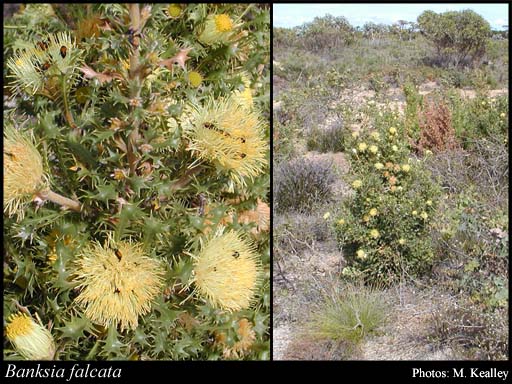- Reference
- Austral.Syst.Bot. 20:67 (2007)
- Conservation Code
- Not threatened
- Naturalised Status
- Native to Western Australia
- Name Status
- Current
Prickly, columnar, non-lignotuberous shrub, (0.4-)0.6-2(-3) m high. Fl. yellow-orange, Sep to Nov or Jan. Sandy soils over laterite or quartzite, gravel, clay.

Scientific Description
Shrubs, 1-3 m high; branchlets hairy. Leaves petiolate, alternate, 40-100 mm long, 15-30 mm wide, hairy; petiole 7-20 mm long; lamina flat, clearly widest above the middle, once divided, pinnately divided, deeply divided, teeth distinctly pointing towards the apex, with 6-13 lobes on each side, the margins flat. Inflorescences hirsute (with long, rough and coarse hairs), yellow; innermost bracts 15-18 mm long, hairy. Perianth 35-39 mm long, hairy or glabrous, all over, limb apex silky (with soft, shiny and appressed hairs), without awns; pistil 37-44 mm long, straight, style glabrous. Follicles hairy, hirsute (with long, rough and coarse hairs), ovate, 6-7 mm long. Flowers in June, July, August or September. Occurs in the South-west (SW) Botanical Province(s), in the Avon Wheatbelt (AW), Jarrah Forest (JF), Mallee (MAL) or Esperance Plains (ESP) IBRA subregion(s).
Distribution
- IBRA Regions
- Avon Wheatbelt, Esperance Plains, Jarrah Forest, Mallee.
- IBRA Subregions
- Fitzgerald, Katanning, Recherche, Southern Jarrah Forest, Western Mallee.
- Local Government Areas (LGAs)
- Albany, Cranbrook, Esperance, Gnowangerup, Jerramungup, Kent, Plantagenet, Ravensthorpe, Wickepin.